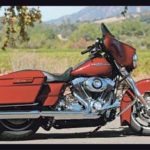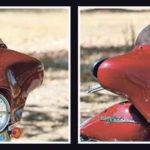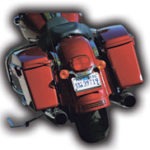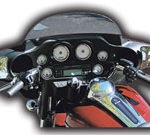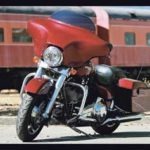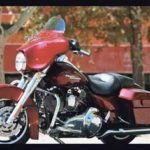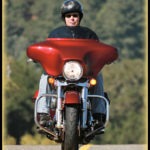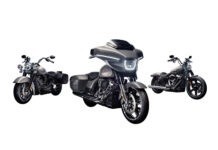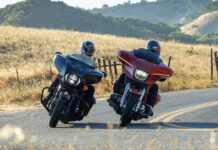Looker for the long haul
Fashion and function cut a sweet deal
Custom bagger. That’s a tough pair of words to reconcile, since virtually every styling detail that contributes to the contemporary custom elan of a bike tends to detract from the utilitarian virtues generally associated with a bagger. Nevertheless, custom baggers have been the hot trend in the industry in recent years, and the trend that the FLHX Street Glide was tasked with addressing when introduced for 2006. As such, the Street Glide’s been obliged to walk a fine line between touring capability and custom curb appeal, and how effectively it’s pulled that off is deserving in and of itself of critical examination. For 2009, though, there’s so much more to talk about. The ground-up redesign of Milwaukee’s Tourer platform needs to be brought into the mix as well, and while we’ve had the opportunity to get familiar with the extensive changes it brought to the line, this is the first chance we’ve had to get out and pound some serious mileage on the configuration, and see how it all shakes out between distant horizons.
In the abstract, it’s the FLHTCU Ultra Classic that benefits most from the many fundamental changes. That model, being fitted with fairing lowers, was in most urgent need of the heat management rethinking that came, and which we’ll get to directly, and being the heavyweight freight liner of the breed it was also the chief beneficiary of the enhanced load capacity of the saddlebags and Tour Pak owing to a beefed up mounting system. That said, the Street Glide comes in a close second, benefiting more than the rest of its stablemates from the complete rear end redesign that brought a 180mm tire and new fender/strut setup to the platform.
There was no particular functional advantage in going to the wider rear rubber, but it was perhaps inevitable considering current fashion trends and the fact that the other Milwaukee platforms—the Dyna, Softail, VRSC and Sportster—had already gone to fatter tires. With the Tourers, that expansion necessitated a complete revamping of the back half of the bikes, cleaning them up substantially in the process. The fat new fender is handsomely contoured, and eliminates the familiar—and visually distracting—tubular loop of the previous chassis. Eliminating that element opened up new possibilities for lighting and license plate placement on all Tourer models, but it was the Street Glide that was just aching for it. Already equipped with super-sanitary fenders, street-level LED light strips, and elegant filler panels between the saddlebags and panniers, the Street Glide wanted only for some serious meat and the elimination of tubular distractions to complete its haute-custom aspirations.
In looking at how the Tourer redesign has improved the platform’s pure touring prowess, there are two areas of primary importance, the first being the aforementioned heat management. It’s no secret that heat building up and radiating from the rear exhaust manifold region of the 96-inch Twin Cam has been the source of widespread complaint, and alleviating it a priority in what the engineers did to the Tourers. The improvement in that department for 2009 has been achieved almost exclusively by a new exhaust system that uses a 2-into-1-into-2 format to reposition the crossover down by the lower frame rail, thus eliminating entirely the troublesome rear cylinder hot spot. Additionally, the rear header was redirected forward and around the transmission cover to get it away from both the seat and the passenger’s leg. That’s a somewhat radical departure visually, and one that serves the Street Glide’s custom credentials nicely.
In operation, the difference in perceptible heat and thus rider comfort is remarkable. A 350-mile straight shot down California’s Central Valley to Bakersfield in temperatures edging over 100 degrees told the tale on that one. The heat emanating from the back of the motor into my thighs and up through the saddle was substantially reduced from what I’ve experienced on Twin Cam Tourers in the past. Even in that ambient heat, it was so insignificant as to be honestly unnoticeable. I only began to notice it in the traffic congestion of Bakersfield, and even then little more than you’d expect to experience on any air-cooled machine in those conditions. And while it never became a factor on this model, the Tourers are also now equipped with a “parade duty” circuit which, when activated by the operator, kills the ignition cycle on one cylinder when the bike’s stopped and the motor’s idling in the heat. Activation is a simple matter of rolling the throttle forward off its stop for a few seconds. It arms or disarms and stays that way until redirected.
Along with heat management, the other primary functional objective of the Tourer redesign was in the handling department—specifically, to take the flex out of the chassis that had previously caused the big bikes to react like they were hinged in the middle under hard cornering. An entirely new two-piece frame was configured, with a stout backbone and a dramatically stiffened swingarm, and the proof of its effectiveness is in the fact that handling is no longer something you particularly notice. Within a few short miles it becomes a matter of faith that the machine will maneuver with aplomb at the subtlest of inputs, and while the 2009 FLHX model is actually a heavier bike than the 2008 by 34 pounds, it feels a whole lot lighter.
In walking that fine line between fashion and function, there are, naturally, areas in which the Street Glide strays into the custom lane by cosmetic necessity, and one of them is in the area of rear suspension where the stylishly slammed appearance of the model demanded a sacrifice of cushy comfort. With the shorter travel of the air shocks comes a concomitant stunting of the range of adjustment, such that finding a balance point between a stiffness that keeps the bike nimble and off-bottom, and a compliance that soaks up jarring pavement is a bitch. I, frankly, gave up. It seems that any measurable air pressure at all in the shocks brings a somewhat harsh ride, and letting all the air out allows the bike to bottom out without actually providing much in the way of bounce. In truth, it’s something you become accustomed to, and after awhile you just accept and embrace the fact that you’ll be standing on the footboards over railroad tracks, and at the end of the day you’ll be allowing your six-pack to rest for awhile before popping one open.
And by rights, the Street Glide’s saddle should be a real pain in the ass, too. It’s a slim affair for sure, and serves the custom bias of the bike nicely, and there’s no reason to suspect it’s actually something you want to sit on all day. But here, looks are deceiving. In reality the thing is a damn comfortable perch and wears well over the long haul, even for a guy like me with the nates of a billy goat. How well? In the course of this review I found myself piling nearly 650 miles on the bike in just over 10 hours; getting off the machine a total of four times in that duration to gas up and slam a snack, and not once did the run become a monkey-butt ordeal.
In riding that far that fast, it helped that the Street Glide’s six-gallon tank took fuel concerns off the table completely. I’ve complained in the past about the vagueness and attendant worry of the low-fuel warning system on fuel-injected Harleys, and especially on the six-gallon Tourers where despite the fact that you knew you were riding well within your range, you found yourself nonetheless being warned continuously by the bike of a low-fuel state. The gas gauge, low-fuel light and range-to-empty readout on the odometer were consistently, laughably out of synch. Not so with this Street Glide. The fuel gauge would indicate empty at about 200 miles, the light would flick on, and the odometer would put up a range of about 40 miles, and they were all pretty much spot-on in informing me that I had about a gallon left in the tank. Fuel economy over the course of this review was 42.9 miles per gallon. Do the math, and it all computes rather neatly.
The other area in which the Street Glide has given up a lot for the sake of appearance is in wind protection. It took me all of about an hour in the saddle of this bike to come to the understanding that the stylishly abbreviated wind deflector atop the batwing fairing would have to go. My head was being buffeted furiously—more furiously than if I had no fairing at all, frankly. I didn’t jettison the thing immediately, though, figuring there must be some simple way to adapt to the blast—perhaps a different helmet choice. So I tried everything from a beanie to a full-face and was rewarded only with a wider variety of miseries, and realized that if I was going to tour this bike the 1,400 miles to Las Vegas BikeFest and back I had planned for the next weekend, drastic steps were called for.
At 6-foot-4 I’m a tall man, but well within the range of conventional Harley riders, and my take on the stock wind deflector of the Street Glide is that if you’re over six feet tall, it will make you unhappy. You need to do what I did, which is to swap the stock unit out for the P&A catalogue replacement that tacks another two inches onto the screen ($119.95). In the subtle realm of windscreen height, two inches can make a world of difference, and that’s proven to be the case here. Another inch would be ideal, actually, but here’s the upshot: Considering how stupidly easy it is to swap out the screen on the Street Glide’s batwing fairing—requiring only a single Torx wrench and about five minutes—you can have the best of both the custom and touring worlds for very little money. Keep the stock screen on for high-style profiling, and keep a screen of practical height on hand for installing before heading to Sturgis.
And as long as we’re spending some money, here’s another idea: With the elimination of that tubular loop on the back fender of the Tourers, we’ve lost what was in practice a handy step on which to bungee gear just aft of the pillion. That’s a loss, but need be only a temporary one since Harley now offers their slick 4-Point Mounting System ($149.95) for the 2009 Tourers that allows you to quickly fasten on a luggage rack or a passenger backrest and detach it just as quickly, leaving no unsightly hardware visible.
The Motor Company has done an admirable job of reconciling good looks and distance touring aptitude on the Street Glide since its introduction, and the changes brought to the 2009 Tourer platform chassis have enhanced both of those sides of the line on this model. The $18,999 buy-in for the bike is an outstanding value for such a capable custom-styled creation loaded up with all the amenities of a luxo-touring machine, and here’s some unsolicited advice to the designers at the Custom Vehicle Operations division of The Motor Company in the interest of making their life even easier than it already is: Just give this Street Glide an exotic paint job, billet grips, and a 110-inch motor and you’ve got your next Screamin’ Eagle machine. There you go. Now go ahead and take the rest of the year off, guys.


